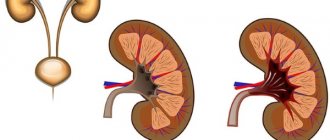Symptoms of diseases
Normal urine for every person should be light yellow in color. Do not contain any impurities, and color changes are not allowed. Any change is a sign of disorders, inflammation and other unpleasant phenomena with the body and its organs. There is no difference between the sexes. If problems occur, the urine changes, and the person should go to the hospital. Pink urine is a sign, evidence that an organ is damaged and very badly. Perhaps even the appearance and development of a cancerous tumor. Such moments cannot be left without due attention.
Possible diseases
Urine may become colored due to certain diseases, namely:
- Pyelonephritis and glomerulonephritis. These diseases develop against the background of renal inflammation of varying severity. When blood vessels are involved in the disease process, their walls become permeable. As a result, some of the red blood cells leave the bloodstream and enter the renal cavity, where they are washed out in the urine. If a person develops the following symptoms against the background of colored urine, then it is worth seeking help from a nephrologist or urologist: pain in the lumbar region, swelling, high blood pressure, headaches, fever, general weakness. Remember that kidney disease can lead to serious consequences, so do not delay treatment.
- Cystitis. This pathology is becoming a common cause of pink urine. This form of bladder inflammation is called hemorrhagic. It is observed mainly in women. Cystitis is characterized by the following symptoms: intoxication, pain in the abdomen, constant urge to go to the toilet, uncomfortable urination, causing a burning sensation. In addition to changes in the color of urine, it contains purulent and mucous impurities.
- Nephrolithiasis. Urine may turn pink due to kidney stones. Concretions often have sharp edges and spines - these are what injure the thin walls of the urinary tract. Often people with urolithiasis experience renal colic, which manifests itself as unbearable pain in the abdomen and lumbar region. They occur at the moment when the stone moves along the ureter.
- Cancerous tumors in various parts of the urinary system. A neoplasm is rarely isolated. Typically, germination occurs in the vascular walls. This contributes to their injury and damage. As a result, blood enters the kidneys, ureters or bladder. In most cases, it depends on the location of the tumor.
- Injury to the kidney, bladder or urethral region. The integrity of the walls of the urinary organ can be damaged by a blow, urological intervention, or other damage. As a result, blood enters the urine and it turns pink.
Systemic diseases can also affect the kidneys. As a result, the urine becomes colored. One of these pathologies is vasculitis.
Thus, the pink color of urine is often caused by blood entering the urinary system. In medicine, there is a term for this – “hematuria”.
But sometimes this condition can develop due to taking unlimited amounts of anticoagulants, for example, salicylates or heparin. They contribute to blood thinning, thinning the walls of blood vessels, as a result of which red blood cells diffuse into urine.
To make sure that there is blood in the urine, you can independently test for the presence of red blood cells in the urine. To do this, purchase test strips from the pharmacy. In addition, the pathological process is accompanied not only by a change in the color of the urine (most often it becomes cloudy) - in the urine one can notice impurities of pus, mucus, flakes and other substances.
Red shades are a sign of blood
In this spectrum, reddish shades immediately raise suspicion of the presence of blood in the urine. When the color turns distinctly red, it becomes clear that this is a sign of severe bleeding (hematuria) in the urinary tract. If the urine acquires a brownish-red tint of “meat slop,” it means that the problem lies somewhere higher, in the kidneys, and the hemoglobin released from the disintegrated red blood cells has already managed to enter into chemical reactions in the urine with a color change from red to brown.
Pink urine indicates that there is little blood in it. This happens when:
- Diseases of the urinary system.
- Injuries of the pelvic organs.
The culprits of staining are usually inflammatory diseases:
- Cystitis (a pathological process in the bladder, more often found in women) - in addition to pink coloration of varying degrees of intensity, it is characterized by the presence of mucus and even pus in the urine, as well as pain in the lower abdomen, aggravated by urination.
- Pyelonephritis (acute or chronic inflammation in the renal pelvis, in which urine is produced) - with it, a change in the color of urine is associated with such clinical signs as:
- severe pain radiating to the lower back;
- general intoxication with headache;
- the appearance of edema (under the eyes - “renal edema”);
- high blood pressure;
- in acute cases - an increase in temperature from subfebrile to 39.5ºС.
Diseases that cause pink color
Why does pink urine have different etiologies in men and women? In men and women, the genitourinary organs are located differently, so they often develop pink urine for different reasons. Thus, in men, urine staining may indicate the development of cancer in the prostate. Do not delay contacting a urologist if the color of your urine has not changed for several days!
Pink urine in women can have completely understandable causes, for example, the use of various contraceptives, especially hormonal ones. They lead to the following consequences on the body:
- blood stagnation;
- weakening of tone in blood vessels;
- rupture of small vessels.
The color of urine may change due to:
- ovarian dysfunction;
- untimely periods;
- uterine bleeding.
Treatment
Treatment of pathologies that lead to the appearance of pink urine depends on the very essence of the disease.
- Immune glomerulonephritis treated with drugs from the group of glucocorticoids and cytostatics . Sometimes the use of diuretics and antihypertensive drugs .
- For inflammatory diseases of an infectious nature, various methods of detoxification and antibiotic therapy .
- To treat renal colic, painkillers are used .
- Treatment of tumor pathology depends on the location and histological type of the tumor. It may consist of surgical treatment, chemotherapy, radiation therapy . Some types of prostate cancer are treated with hormone therapy .
Non-pathological causes
Urine from a healthy person is whitish or yellowish in color and is not accompanied by a sharp putrid or sour odor. Pink color does not always indicate pathology. This circumstance may be affected by food eaten the day before or certain medications.
Thus, the following products contain a special coloring pigment:
- Pink urine after beets is the most common occurrence.
- Berries such as blueberries and blackberries can also stain your urine.
- Cherry.
- Red or black currant.
- Products with added food coloring can be candy, cakes, drinks, etc.
In addition, some medications can color the urine, such as:
- Which contain phenolphthalein (Phenaloyl, Purgil, Purgen, Laxoil).
- Salicylates (Anacin, Aspirin, Citramon, Askofen).
- Preparations based on Ibuprofen.
- Rifampicin is a class of antibiotics.
Remember that if the color of urine is affected by food or medicine, then it does not lose its transparency, as with various diseases.
Natural causes of urine color change
Changes in the shade, concentration and smell of discharge may be indicators of the introduction of unusual foods into the daily menu. For example, the modern food industry offers a large selection of sweets to which various coloring agents have been added. Parents may notice corresponding shades in the urine of children and teenagers who consume large quantities of candy and carbonated water.
Experts note the following list of foods that can cause pink urine:
- red beets have a pronounced pigment, which, entering the organs of the gastrointestinal tract, is excreted unchanged through the urinary organs;
- eating rhubarb can lead to coloration of urine only if its pH is alkaline;
- with increased acidity of the secreted liquid, black currants can color it;
- Berries such as blackberries and cherries change the color of urine;
- A large amount of carrots, both fresh and thermally processed, contributes to color change.
In addition to the listed factors, taking certain medications can cause urine color to change.
These include:
- drugs containing salicylates, for example, Cardiomagnyl, Aspirin, Citramon, etc.;
- anti-tuberculosis semisynthetic antibiotic Rifampicin and medications based on the same active substance;
- Aminophenazone, Piramon and other drugs containing amidopyrine;
- laxatives whose active ingredient is phenolphthalein;
- Ibuprofen and other propionic acid derivatives.
What can happen to children?
The same as in adults, a change in the color of urine in a child may be normal, but sometimes it indicates pathology.
Non-pathological reasons:
- When adding various juices to the baby’s diet, including beet juice.
- If there is a slight excess in the concentration of urates in the child’s urine. The situation does not require medical intervention.
- Pink urine in a child is possible as a reaction of the diaper material, and it also changes its normal color.
- If a child is forced to take medications, the urine may change color depending on the composition of the drug.
In what cases does pink urine indicate a disease:
- If the baby suffers from hemorrhagic diathesis.
- When the baby’s health changes for the worse, an accumulation of amorphous salts may be observed in the urine.
- Kidney diseases in the acute stage.
Do not hesitate to go to the doctor when it comes to a small child. You cannot determine the cause of pink urine on your own, so seek help from a specialist.
What should normal urine look like?
The appearance of urine is assessed according to a number of criteria. Thus, the color of urine in a healthy person usually varies from light shades of yellow to amber. However, it may differ at different times of the day. It is influenced by factors such as physical activity and external temperature, as well as diet and amount of fluid consumed, diuretic products and medications. Short-term changes in the color of urine caused by temporary exposure to such causes are absolutely physiological and return to normal characteristics after the end of their influence.
Normally, urine has a specific odor, but it should not be pungent. If the metabolic product has prolonged contact with air, then during the oxidation process the urine acquires a pronounced ammonia “aroma”. When eating foods with a strong specific odor (garlic, horseradish, natural coffee), it can also be transmitted to urine.
The clarity of urine depends on the salt content in it. Normally, fresh urine should be clear. After a short time, slight turbidity is allowed, in the form of a small cloud, which after some time can turn into a total turbidity of the entire volume. This condition is not pathological, but occurs due to the presence of various salts in the urine and is a type of normal.
What can be done?
As it was found out, the reasons for the appearance of pink urine vary: from harmless to pathological conditions. Therefore, the advice of a pediatrician in this case will not hurt. The first thing the doctor will do is send you for urine tests and an ultrasound of the pelvic organs.
If you are sure that your baby’s reddish urine is due to food, then you should temporarily exclude them from the diet. If its color has changed, then you were not mistaken: this is normal, and nothing else needs to be done.
Often in newborn children (and not only) the color of urine changes due to dehydration; in this case, give the baby more to drink. Dehydration can also occur at high temperatures. In this case, everything liquid will also come to the rescue. The urine concentration will decrease and it will return to its normal color. If you find pink spots on the diaper, then try changing the brand or completely abandon these devices and use regular diapers.
Gender
If we talk about the possible reasons for the change in urine color, it is worth taking into account the gender and age of the patient. So, for adult men, red urine can be a sign of cancer. We are talking about prostate cancer. This disease is characterized by a number of additional symptoms.
We are talking about weakness, sudden weight loss. A high temperature often sets in, and in general, the person begins to feel worse. To make an accurate diagnosis in this case, a consultation with a urologist and oncologist and additional diagnostic measures are required.
If we talk about the fairer sex, they may have their own reasons for detecting pinkish urine. Taking oral contraceptives can affect the color of urine. Any problems with the menstrual cycle or failure of the ovaries to fulfill their functions are reflected in a change in the color of the urine.
When taking hormonal contraceptives on a long-term basis, blood stagnation occurs in the pelvic organs. A bloody tint can also be the result of decreased vascular tone, which leads to rupture of small vascular networks. This provokes small bleeding. Other reasons that women should think about may include decreased blood clotting and pathologies of the reproductive system.
Urinalysis according to Nechiporenko
This method of laboratory testing of the state of urine was first invented in 1916 by the Soviet scientist Z. Nechiporenko. The main task of the analysis is to identify the presence of infectious or inflammatory processes in the urethra, as well as to determine the number of leukocytes (white blood cells), which serve as an “alarm bell” about the presence of the disease.
Even a slight deviation from the norm is already an indicator of inflammatory processes in the genitourinary system. This analysis has proven its effectiveness more than once, and has also repeatedly helped to make an accurate diagnosis for the patient.
The most important thing is not to hesitate. As soon as it becomes painful to go to the toilet, you must immediately visit a urology office to prevent possible negative consequences.











